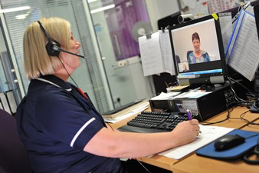Dr David Barrett, Faculty of Health Sciences, University of Hull; @barrett1972
Since the start of 2020, the Covid-19 pandemic has impacted on all areas of society – none more so than health and social care. Nurses and other professional groups have had to find innovative approaches to delivering care services in fast-changing conditions, during differing levels of societal restriction, and with an emphasis on suppressing the spread of the virus.
One consequence of this has been the increasing role that technology has played in the delivery of healthcare. For many years, there has been a gradual increase in the use of telehealth – the use of technology to facilitate the remote provision of healthcare. This approach to care offers a range of benefits: it can empower patients to play a more proactive role in their care, and can enable the delivery of care across geographical distance and barriers. Nonetheless, its growth has been hampered previously by issues such as cost, technophobia, reliability and availability of technology, and the impact of remote care on the practitioner-patient relationship.1
 Covid-19 has changed much of this, and we have seen a rapid increase in the use of telehealth services, including telephone, video and online consultations between patients and practitioners. In part, this is because there has been a need to reduce physical attendance at healthcare settings in a bid to curb virus transmission. This relates not only to reducing exposure for service users (and particularly those who may be more clinically vulnerable), but also for healthcare practitioners2. As a result, there has been a rapid switch to using telehealth in areas such as primary care, community nursing and outpatient services.
Covid-19 has changed much of this, and we have seen a rapid increase in the use of telehealth services, including telephone, video and online consultations between patients and practitioners. In part, this is because there has been a need to reduce physical attendance at healthcare settings in a bid to curb virus transmission. This relates not only to reducing exposure for service users (and particularly those who may be more clinically vulnerable), but also for healthcare practitioners2. As a result, there has been a rapid switch to using telehealth in areas such as primary care, community nursing and outpatient services.
Also, the societal lockdown experienced in many countries has resulted in the use of remote communication tools and online services becoming much more prevalent. For many of us, our default method of communication – whether for work meetings or a family get-together – is now video. As a result, healthcare users and practitioners are likely to be more accepting of technology to facilitate remote communication for clinical reasons, as they have for social interaction.
So, what does this mean for nurses? For those who are finding themselves using technology to deliver care, there is need to adapt the way in which we work. Nurses still need to carry out the fundamentals of nursing – they need to assess their patients, identify needs, prescribe and deliver evidence-based nursing care, and evaluate effectiveness. They need to demonstrate compassion to patients and carers; they need to be ‘present’, whilst being remote.
Research carried out pre-Covid gives us some insights into what these adaptations in care might be. Nurses who triage patients via telephone services compensate for the lack of visual cues through more detailed consideration of indicators such as tone of voice and breathing sounds.4 Where nurses have utilised video to communicate with patients, a range of compensatory tools have been identified, including asking third parties who are with the patient to provide ‘hands-on’ assistance with tasks such as assessing grip strength or simply moving a camera to allow for a more specific view.3
There is no doubt that when we begin to return to some sort of post-Covid normality, some of these technological solutions will remain in place. Even as social restrictions are eased, there will continue to be more phone triage, more video clinics and more online consultation than previously. Some patients will see this as a positive development, valuing the convenience and accessibility of telehealth. However, remote consultation is not always appropriate. Some patients will not adjust to the use of technology and will always yearn for face-to-face interaction; some assessments simply cannot be done properly without being physically present; some news should only be broken in person.
As a result, nurses also have a critical role to play in identifying when it may not be appropriate to use technology to facilitate care. They need to ensure that where technology is used to communicate with patients remotely it is only done as a means to an end – provision of high-quality care in circumstances where the patient and professional are distant – rather than as an end in itself.
The past months has seen a level of disruption to the provision of nursing care that has led to lasting change. However, no matter how we interact with others, the fundamentals of nursing – providing compassionate, evidence-based, holistic and individualised care – must never change.
References
- Cooper A, Dowding D, Barrett D (2015) The impact of new information and communication technologies on the development of advanced practice. In: Barton D, Allan D (Eds) Advanced Nursing Practice: Changing Healthcare in a Changing World. London, Palgrave Macmillan. 288-302
- Fisk M, Livingstone A, Pit SW. Telehealth in the Context of COVID-19: Changing Perspectives in Australia, the United Kingdom, and the United States (2020) Journal of Medical Internet Research. 22(6):e19264. Published 2020 Jun 9. doi:10.2196/19264
- Barrett D (2017) Rethinking presence: a grounded theory of nurses and teleconsultation. Journal of Clinical Nursing 26(19-20):3088-3098. doi:10.1111/jocn.13656
- Pettinari, C.J.. and Jessopp, L.. (2001), ‘Your ears become your eyes’: managing the absence of visibility in NHS Direct. Journal of Advanced Nursing, 36: 668-675. doi:1046/j.1365-2648.2001.02031.x